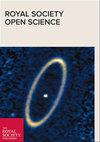犹他州马朱姆地层中的一种新海绵记录了寒武纪六角星虫身体结构的起源。
IF 2.9
3区 综合性期刊
Q1 MULTIDISCIPLINARY SCIENCES
引用次数: 0
摘要
现代多孔动物被分为四类--钙孔动物门(Calcarea)、多孔动物门(Demospongiae)、六孔动物门(Hexactinellida)和同孔动物门(Homoscleromorpha)--在化石标本中对它们的识别几乎完全依赖于孢子的形态和排列。多孔动物门的早期化石代表在形态上多种多样,其中许多化石的特征与为现代类群制定的分类方案不符,这一点很成问题。至关重要的是,在寒武纪和奥陶纪的各种类群中发现了 hexactinellid spicules--在现代类群中 hexactinellid 的诊断特征--而这些类群无法被容纳在 hexactinellid 的身体结构中。在这里,我们描述了来自犹他州德鲁米安-马朱姆地层的一种新的多孔动物--Polygoniella turrelli gen.这个新物种的类己内酯体壁结构支持己内酯体的寒武纪起源,并为早期玻璃海绵的特征演化提供了宝贵的见解。本文章由计算机程序翻译,如有差异,请以英文原文为准。
A new sponge from the Marjum Formation of Utah documents the Cambrian origin of the hexactinellid body plan.
Modern poriferans are classified into four classes-Calcarea, Demospongiae, Hexactinellida and Homoscleromorpha-the recognition of which in fossil specimens almost exclusively relies on spicule morphology and arrangement. Early fossil representatives of the phylum Porifera are morphologically diverse, and many of them problematically display characteristics that are incompatible with the classification scheme developed for modern taxa. Critically, hexactine spicules-a diagnostic feature of hexactinellids among modern taxa-are found in various Cambrian and Ordovician taxa that cannot be accommodated within the hexactinellid body plan. Here we describe a new poriferan from the Drumian Marjum Formation of Utah, Polygoniella turrelli gen. et sp. nov., which exhibits a unique combination of complex anatomical features for a Cambrian form, including a syconoid-like organization, a thick body wall, and a multi-layered hexactin-based skeleton. The hexactinellid-like body wall architecture of this new species supports a Cambrian origin of the hexactinellid body plan and provides valuable insights into character evolution in early glass sponges.
求助全文
通过发布文献求助,成功后即可免费获取论文全文。
去求助
来源期刊

Royal Society Open Science
Multidisciplinary-Multidisciplinary
CiteScore
6.00
自引率
0.00%
发文量
508
审稿时长
14 weeks
期刊介绍:
Royal Society Open Science is a new open journal publishing high-quality original research across the entire range of science on the basis of objective peer-review.
The journal covers the entire range of science and mathematics and will allow the Society to publish all the high-quality work it receives without the usual restrictions on scope, length or impact.
 求助内容:
求助内容: 应助结果提醒方式:
应助结果提醒方式:


